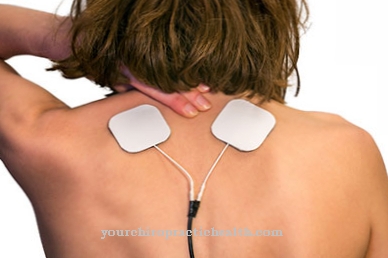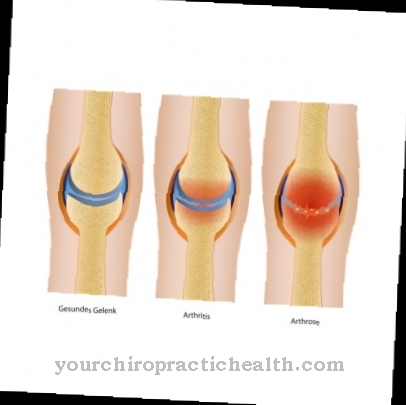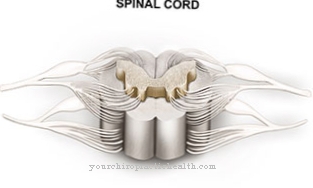If one or both testicles are not in the scrotum after the birth of a child, it is a developmental disorder, the Undescended testicles. Such undescended testicles almost always require medical treatment.
What is an undescended testicle?
.jpg)
© elvira fair - stock.adobe.com
About 1-3% of all male infants and 30% of all premature babies are from one Undescended testicles affected. The undescended testicle is a developmental disorder in which either one or both testicles have not migrated into the scrotum. Usually the testicles move into the scrotum around the seventh month of pregnancy.
It is possible that within the first year of life there is a delayed, independent migration of the testicles into the scrotum. In general, a distinction is made between 3 types of undescended testicles:
Inguinal testicles: The abdomen and scrotum are connected by the inguinal canal, in this case the testicle is located here
Sliding electrodes: The testicle is repeatedly drawn back into the inguinal canal based on the fact that the spermatic cord of the testicle is too short
Abdominal testicles: It is not possible to feel the testicle because it is in the abdominal cavity
The pendulum testicle is to be distinguished from these forms. The pendulum testicle is not a disease but rather the reflex-like displacement of the testicle from the scrotum into the inguinal canal; this is not an undescended testicle.
causes
A Undescended testicles can have both an anatomical and a hormonal cause. For example, there may be an inguinal hernia or the inguinal canal is too narrow so that the testicle has no way of moving into the scrotum.
Due to hormonal factors, the child's development in the womb can be delayed, which also affects the migration of the testicle. In principle, the testes of the unborn baby develop in the kidney area.
Since the temperature outside the body, in the scrotum, is optimal for sperm production, the testicles migrate into the scrotum during development. Often, however, an undescended testicle does not have a clear cause.
Symptoms, ailments & signs
The main symptom of undescended testicles are testicles that have incompletely migrated down from the abdominal cavity after birth. This can affect one or both testicles. The testicles can either be perceived in the entrance area of the scrotum or not at all. There can be different forms of undescended testicles, the symptoms of which can be different.
The abdominal testicle (cryptorchidism) can usually not be felt at all. A pendulum testicle lies in the scrotum, but moves back into the groin when it is cold. An inguinal testicle can be felt in the groin, but not inserted into the scrotum. In contrast, a sliding tode can be inserted into the scrotum, but from there it returns to the groin.
A testodectomy is particularly rare. This means that the testicle is not in its natural path, but rather in the thigh or on the perineum. As a rule, the testicles, although not in the correct position, are normally formed and developed. In childhood, undescended testicles are not associated with any other symptoms.
If it persists, this can lead to a number of long-term consequences. Most importantly, there is a risk of infertility. Testicular cancer can also occur. Affected adults also complain of pain in some cases.
Diagnosis & course
During the U1 examination of the newborn, undescended testicles can be diagnosed by a pediatrician. In order to be able to make a diagnosis, the doctor feels the scrotum while the child is in a standing, sitting and lying position one after the other.
If it is not possible for the doctor to feel the testicles, a hormone stimulation test is carried out, this is used to detect testicular tissue. Further diagnostic methods are carried out using a laparoscopy as well as MRI and ultrasound. However, these procedures are not performed regularly for undescended testicles.
A undescended testicle that is treated too late can have various serious consequences over time. Already damaged testicular tissue can lead to infertility. This occurs in around 30% of those affected. An undescended testicle also increases the risk of an inguinal hernia and subsequent testicular cancer.
Complications
If an undescended testicle is not treated medically in good time, there is a risk of serious complications in the further course. These mostly show up from adolescence. Babies and children rarely experience the immediate effects of undescended testicles such as hormonal imbalances or pain.Although the testicles do not fit properly, they are normal.
However, adolescents who develop sexual awareness are at risk of psychological distress if one or both testicles are not in the scrotum. As a rule, undescended testicles are treated before the first birthday, so this is rarely the case.
Without therapy, there is a risk of sequelae in adulthood, including testicular torsion (twisting of the testicles). The rotation of the testicle on the spermatic cord is often caused by the incorrect location of the testicle. As a result, there is a risk of constriction of the vessels supplying the testicles, so that the testicle can die without rapid treatment.
In the case of an inguinal or sliding ode, weak points form within the inguinal canal in some affected persons. This in turn makes it possible for intestines to break in from the abdominal cavity, which doctors call an inguinal hernia.
Another complication is infertility. If the Maldescensus testis is only available in one testicle, this has little effect. However, if both testicles are affected, significantly fewer children are sometimes conceived. Furthermore, undescended testicles can have a positive effect on testicular cancer. The risk of cancer increases twenty-fold without treatment.
When should you go to the doctor?
An undescended testicle is usually diagnosed by the pediatrician immediately after birth and treated immediately. Medical treatment is required at the latest if the misalignment of the testicles causes pain or other complaints. Parents who notice signs of this in their child are best to speak to the pediatrician. If serious complications arise, the child must be treated in hospital. Parents should immediately arrange for an examination to minimize the risk of long-term effects such as infertility or testicular cancer.
People who have been diagnosed with undescended testicles in childhood and treated should consult their family doctor or a urologist regularly in later life. A full examination will ensure that the testicle is properly positioned and not causing any problems. In addition, any triggers such as hormonal fluctuations can be identified and remedied at an early stage before an undescended testicle occurs. If the malfunction is due to a serious illness, close monitoring by a specialist is required. Treatment is usually carried out in a specialist urology clinic.
Doctors & therapists in your area
Treatment & Therapy
The testicle sinks in one Undescended testicles If the patient does not stop independently within the first six months of life, treatment by a urologist is recommended. However, before surgery is performed, hormonal therapy should be performed. In hormone therapy, the hormone gonadotropin is administered. It is supposed to ensure that the testicle moves (further) into the scrotum.
The hormone can be absorbed through the mucous membrane in the form of a nasal spray or it can be injected intramuscularly. Hormone therapy for undescended testicles is successful in 20% of all cases. There are exceptions when surgery should be performed. These exceptions include:
- Undescended testicles during puberty
- Simultaneous inguinal hernia
- Unsuccessful hormone therapy
- Abnormal positioning of the testicle
During an operation, the testicle is surgically moved into the scrotum and sewn into the deepest point there. If the testicle is already atrophied, it is removed to avoid further consequential damage. In any case of undescended testicles, regular checks are necessary from the age of 15.
You can find your medication here
➔ Medicines for painOutlook & forecast
Within the first year of life, the affected testicle can in rare cases migrate into the scrotum by itself without treatment. However, this becomes less and less likely as you get older. The earlier the undescended testicle is treated surgically or with hormones, the lower the risk of long-term complications or secondary diseases.
The prognosis with hormone therapy is significantly better if the affected testicle has already migrated towards the scrotum. Hormonal therapy is successful in around 20 percent of those affected. However, around 25 percent of the testicles that were initially successfully treated migrate back up from the scrotum after hormone therapy. The prognosis is significantly better for surgical treatment. In five percent of those affected, the treated testicle moves up again after the operation.
Consequential damage from undescended testicles or surgery is rare. The testicles may have been damaged and dysfunctional even before successful treatment. After an operation, the testicle can also become stunted (atrophy). If neither hormonal nor surgical treatment is successful, surgical removal of the testicle is often recommended as there is an increased risk of cancer. Even after successful treatment, the likelihood of developing testicular cancer is slightly higher.
prevention
Since it is a Undescended testicles When it comes to a developmental disorder, there are no preventive measures. Long-term effects can only be avoided by treating an undescended testicle with early control examinations.
Aftercare
If the undescended testicle is treated surgically, a grace period must be observed after the operation. For optimal wound healing, the patient should stay in bed for two days and rest. Physical activity should be avoided during this time. Bed rest can take place in the hospital as an inpatient or at home on an outpatient basis.
Even after successful surgical or hormonal treatment, the testicles may come back up again. So-called atrophy, stunting of the testicles, is also possible. In order to be able to record these possible complications, close monitoring is recommended. Follow-up examinations should be taken every three months.
The size and position of the testicles is assessed using ultrasound. If the position of the testicles is not satisfactory six months after the end of the therapy, the patient usually has to return to the attending surgeon. If the findings are normal, further follow-up checks are necessary every three months to one year after the operation.
In addition, patients should return to follow-up care from the age of fifteen. Here, those affected are examined for malignancies on the testicles. The examination can be carried out by the pediatrician in charge. Alternatively, general practitioners and urologists can also take care of this.
In addition, according to the S-2 guideline, it is recommended that the adolescents examine themselves at regular intervals. Any enlargement of the testicles should be reported to a doctor immediately. This is especially the case when the enlargement occurs without pain.
You can do that yourself
Medical treatment is required if the child has undescended testicles. The hormone therapy that takes place first can be supported by alternative methods from naturopathy and homeopathy in consultation with the doctor.
The most important measure, however, is to observe the child. The behavior of the child can tell relatively quickly whether the hormone therapy is successful, because a lowering of the testicle is often noticeable through a reduction in pain. The affected testicle should be checked regularly by a doctor, because this is the only way to ensure that a lowering actually takes place.
If the undescended testicle persists despite hormonal treatment, an operation must be performed. Since this is a routine procedure, the child does not need to be specially prepared for it. It is important to relieve the child of any fears and to make the time in hospital as pleasant as possible. The developmental disorder should be discussed with older children, preferably together with the pediatrician, who can explain the reasons for the disorder to the person concerned and at the same time relieve fears about a surgical procedure.
After the operation, the child should stay at home for a few days and take it easy. Above all, physical activity should be avoided in the first time after an operation.





.jpg)





















